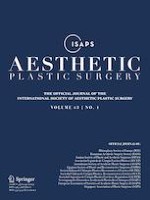Erschienen in:

11.07.2018 | Original Article
Sub-muscular Breast Augmentation Using Tumescent Local Anesthesia
verfasst von:
Alberto Bolletta, Luca Andrea Dessy, Luca Fiorot, Alessio Tronci, Antonio Rusciani, Pedro Ciudad, Emilio Trignano
Erschienen in:
Aesthetic Plastic Surgery
|
Ausgabe 1/2019
Einloggen, um Zugang zu erhalten
Abstract
Background
Tumescent local anesthesia (TLA) consists of infiltration of saline solution with lidocaine and epinephrine into the tissues to obtain regional anesthesia and vasoconstriction. The use of TLA in augmentation mammoplasty has been described for sub-glandular positioning. We describe a modified TLA technique for primary sub-muscular breast augmentation reporting our experience during the past 7 years.
Methods
From 2010 to 2017, 300 patients underwent bilateral primary sub-muscular breast augmentation under TLA and conscious sedation. The tumescent solution was prepared with 25 mL of 2% lidocaine, 8 mEq of sodium bicarbonate, and 1 mL of epinephrine (1 mg/1 mL) in 1000 mL of 0.9% saline solution. Firstly, the solution was infiltrated between the pectoral fascia and the mammary gland, secondarily, during surgery, under the pectoralis major muscle.
Results
The average amount of tumescent solution infiltrated while performing TLA was 740 mL per breast. No signs of adrenaline or lidocaine toxicity were reported and conversion to general anesthesia was never required. In all patients, no pain nor discomfort was reported during the pre-operating infiltration and surgical procedure. We reported a major complication rate of 3.3% (4 hematomas and 6 seromas) and a minor complication rate of 6.0% (8 implant dislocation and 10 dystrophic scars formation).
Conclusions
TLA represents a safe and efficacious technique for performing breast augmentation surgery with sub-muscular implant positioning. This technique guarantees good pain control during and after surgery and has low incidence of postoperative side effects. Patients subjected to sub-muscular breast augmentation with TLA were satisfied.
Level of Evidence IV
This journal requires that authors assign a level of evidence to each article. For a full description of these Evidence-Based Medicine ratings, please refer to the Table of Contents or the online Instructions to Authors
www.springer.com/00266.